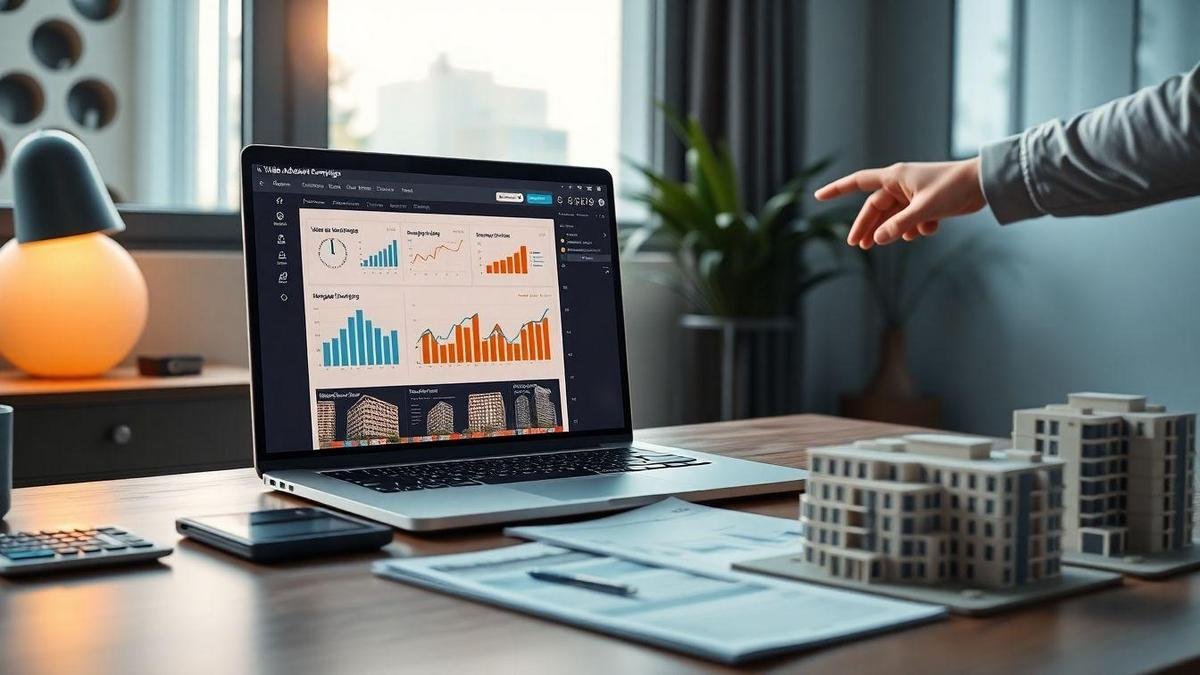YouTube marketing for real estate developers
YouTube marketing for real estate developers provides a clear playbook: set sharp channel goals, lock in consistent branding, pick a strong name, design a clean banner, and organize smart channel sections. Use high‑impact video ideas — model home tours and walkthrough formats, construction behind the scenes, and well‑crafted drone footage — plus solid SEO for property listings for titles and descriptions, short script hooks, click‑ready thumbnails, and clear lead‑capture CTAs. Plan shots, staging, a content calendar, ad tests, and measurement so videos turn into real leads and real sales.
Key takeaway
- Use short property tour videos to boost engagement.
- Add clear titles and keywords for search.
- Put contact links and calls to action in descriptions.
- Highlight local market facts and client testimonials.
- Track analytics and adjust content often.

Why YouTube marketing for real estate developers works
YouTube combines visual storytelling with search intent. For developers, it means showing space, progress, location, and lifestyle — at scale — while capturing leads directly from video assets. When paired with good search optimization, repeatable formats, and measurable CTAs, YouTube becomes a cost‑effective channel for awareness and sales.
Channel strategy and branding
How developers set clear channel goals
Start with one measurable goal per quarter: lead generation, brand awareness, property sales, or community building. Use the SMART framework (specific, measurable, achievable, relevant, timed). Example: get 150 qualified leads in 90 days from video CTAs. Track views, CTR, watch time, and conversion rate.
Goals, KPIs and video types:
| Goal | Key Metrics (KPIs) | Best Video Types |
|---|---|---|
| Lead generation | Leads, conversion rate, CTA clicks | Walkthroughs, gated tours, lead magnets |
| Brand awareness | Views, reach, subscribers | Neighborhood tours, developer story, timelapses |
| Sales | Inquiries, appointments booked | Virtual tours, pricing explainers, testimonials |
| Community | Comments, shares, repeat viewers | Q&A, live events, behind‑the‑scenes |
Run weekly checkpoints and test one variable at a time (e.g., thumbnails for two weeks to compare CTR).
How developers build consistent branding
Pick a visual style, a consistent voice, and 3 content pillars (e.g., listings, neighborhood, education). Use a short style guide for color, font, thumbnail layout, and an intro/outro. Consistency builds trust and improves recognition — pair this with a clear branding strategy to keep assets aligned across channels.
Core actions:
- Define target audience and persona.
- Pick 3 content pillars.
- Create a simple style guide.
- Keep intros short and repeat a sign‑off.
Branding elements and actions:
| Element | Action |
|---|---|
| Logo & colors | Same logo position and palette in every asset |
| Voice | Friendly, expert, concise |
| Thumbnails | Bold text, face or property image, same layout |
| Intro/Outro | 5–8 sec intro; consistent CTA in outro |
| Upload cadence | Fixed days/times; mention schedule in banner |
Plan a content calendar. Posting similar formats on fixed days trains your audience.
Channel name, banner and sections best practices
- Name: keep it short and clear; include city or brand if useful.
- Banner: one‑line value proposition, a CTA (e.g., Tour bookings: link below), and upload days in large fonts.
- Sections/playlists: group by property type, neighborhood, and buyer stage; pin a channel trailer.
Examples and quick tips:
| Area | Example | Quick Tip |
|---|---|---|
| Name | CityName Developments | Keep under 25 characters |
| Banner text | New Homes Tours • Wed & Sat | Use contrast and big fonts |
| Playlist | Family Homes — Tours | Put high‑converting videos first |
| Trailer | 30–60 sec | Start with the main benefit in 5 sec |
Check the channel on mobile — most viewers use phones.

YouTube video ideas that attract buyers
Model home tours and floor plans
Use YouTube marketing for real estate developers to turn plans into feelings. Show how spaces flow and how light falls. Help buyers imagine living there — and consider pairing tours with broader video marketing strategies for distribution and repurposing.
Key approaches:
- Short walk‑throughs focused on layout and flow.
- Drone overviews for context.
- Close‑ups of finishes and staging.
- Animated floor plans with voiceover.
Video types for model homes:
| Video type | Length | Purpose | Must‑capture shots |
|---|---|---|---|
| Guided walk‑through | 2–5 min | Show flow and room scale | Entry, main rooms, outdoor space |
| Floor‑plan animation | 60–90 sec | Explain layout | Moving cutaways, labels |
| Lifestyle vignette | 1–3 min | Show how spaces are used | Staged living scenes, natural light |
| Drone context | 45–90 sec | Show location and views | Neighborhood, access, green spaces |
Practical tips: strong hook in first 10 seconds; use natural light; add text overlays for square footage; end with a clear CTA.
Construction behind‑the‑scenes
Behind‑the‑scenes builds transparency and trust. Share weekly progress, time‑lapses, short interviews with site managers, and materials spotlights — content that complements broader content marketing and email updates.
Quick shoot plan for construction BTS:
| Shot | Length | Purpose |
|---|---|---|
| Site overview | 15–30 sec | Show scale and progress |
| Close‑up work | 10–30 sec | Show craftsmanship |
| Interview clip | 30–60 sec | Explain decisions |
| Time‑lapse | 15–60 sec | Compress long work into short story |
Story tips: keep updates regular, use captions for noisy sites, show setbacks and fixes — honesty wins.
Content calendar tips
A simple schedule wins. Example monthly plan (one video/week):
| Week | Focus | Goal | CTA |
|---|---|---|---|
| Week 1 | Model home tour | Show layout | Book viewing |
| Week 2 | Construction update | Build trust | Subscribe / follow |
| Week 3 | Materials highlight | Show quality | Download spec sheet |
| Week 4 | Neighborhood tour | Sell lifestyle | Contact agent |
Practical rules: batch shoots, keep titles keyword‑focused, thumbnails should show people or a strong interior, and repeat formats that generate leads. Coordinate your calendar with broader social media marketing for developers to amplify reach.

YouTube SEO for real estate listings: titles, tags and descriptions
Keyword research for property videos
Start with search intent: what will the buyer type? Gather seed phrases (e.g., “2‑bedroom condo near downtown”, “new homes with pool”). Use YouTube autocomplete and top video scans. Tools: Google Trends, TubeBuddy, vidIQ. Mix short and long‑tail keywords and follow guidance from real estate SEO experts.
Checklist:
- Find 5 seed phrases.
- Check autocomplete and related videos.
- Compare competition in a tool.
- Choose one primary keyword and 2–3 secondary phrases.
Example:
Primary keyword: “Brickell luxury loft tour 2 bed” — place it early in title and description.
Descriptions that help search
Write the first two lines as a clear summary with the primary keyword (this shows in search). Add factual details: address, price range, bedrooms, sq ft, and a short CTA. Paste a short transcript or talking points lower in the description to help indexing. Include timecodes and 5–8 tags.
Compact description layout:
| Section | What to include |
|---|---|
| Opening | Primary keyword short hook |
| Details | Address, specs, price band |
| Links | Floor plan, contact, site |
| Tags | 2–3 relevant hashtags |
Timestamps and chapters for discovery
Break the video into sections and add timestamps starting at 00:00. Chapter titles should contain keywords: “Kitchen tour”, “Master suite”, “Building amenities”. Chapters help viewers jump in and increase relevance signals.
Example timestamps:
00:00 Intro and building exterior
00:30 Living room tour
01:20 Kitchen and appliances
02:10 Master bedroom
03:05 Balcony and view
03:45 Closing and agent contact

Property walkthroughs: shot planning, lighting, and staging
Plan shots room by room
Map each room with primary shots, secondary details, and the flow between spaces.
Room shot plan:
| Room | Recommended shots | Purpose |
|---|---|---|
| Entry / Hall | Wide entry, show path | Orient buyer |
| Living Room | Wide sweep, corner-to-corner | Show space & light |
| Kitchen | Wide, countertop close‑ups | Highlight function & finishes |
| Bedroom | Wide, closet, window view | Convey size & comfort |
| Bathroom | Wide, fixtures, tile details | Present materials |
| Outdoor / Balcony | Wide, view, access point | Sell lifestyle |
Keep shots short and plan transitions like a real walk‑through.
Lighting and staging basics
Prioritize natural light. Match color temperature and avoid mixed bulbs. Staging should be clean with neutral accents.
Lighting & staging tips:
| Tip | Why it matters | Simple action |
|---|---|---|
| Use daylight | Looks natural | Shoot near windows |
| Match color temp | Avoid tint | Turn off mixed lamps |
| Soft fill | Reduce shadows | Use reflector or LED |
| Declutter | Makes rooms feel bigger | Remove personal items |
| Neutral accents | Helps imagination | Add plant or throw |
Camera movement and gimbal best practices
Move like a calm guide. Slow, steady moves feel natural.
Movement rules:
- Start with a stable wide.
- Keep the gimbal low and level.
- Use one smooth move per room.
- End with a still shot of the room or view.
Movement types and tips:
| Movement | Effect | Tip |
|---|---|---|
| Push in | Personal | Slow and steady |
| Pan | Shows width | Eye level |
| Walk‑through | Simulates a tour | Walk smooth; plan footing |
| Orbit | Highlights feature | Slow circle, 10–20s max |
Walk the path once without filming to spot obstacles.

Drone footage tips for listings and safety
Follow legal rules and flight permissions
Check local regulations: register drones and pilots if required. Check for no‑fly zones, active NOTAMs, and municipal restrictions. Get written property owner consent and confirm neighbor privacy. Keep insurance and a risk assessment on file — and review professional guidance on drone photography best practices.
Key steps:
- Register drone and pilot (if required).
- Request flight permissions early.
- Keep a flight log and insurance docs.
- Respect privacy and posted restrictions.
Capture the best aerial shots
Plan shots like a short film. Scout pre‑flight, shoot at golden hour when possible, and mix wide overviews with reveal and orbit shots. Smooth movement and clear captions increase engagement.
Shot types:
| Shot Type | Purpose | Tip |
|---|---|---|
| Establishing wide | Show location | Fly high, slow pan |
| Reveal | Entrance drama | Start high, descend slowly |
| Orbit | Feature highlight | Keep constant distance |
| Low pass | Landscaping/access | Stay under 5 m/s for clarity |
Tailor clips for platform: short segments for social, longer narrative for YouTube listings.
Altitude, speed and framing
Choose altitude by goal and law. Fly slower for cinematic reveals.
Guidelines:
| Purpose | Altitude (m) | Speed (m/s) | Framing tip |
|---|---|---|---|
| Close detail | 5–20 | 1–4 | Rule of thirds; keep horizon level |
| Property overview | 30–80 | 3–6 | Center property with negative space |
| Neighborhood context | 80–120 | 4–8 | Show roads, access, landmarks |
Use ND filters when needed and check battery and wind.

Video scripts and CTAs
Open with a clear value statement
Hook viewers in the first 3–5 seconds. Answer “Why watch this?” with a one‑line value statement tied to the title and to YouTube marketing for real estate developers.
Examples:
- “Discover a faster path to sell units.”
- “See how this floor plan saves buyers time and money.”
- “A quick tour that shows the best investment angle.”
Short calls to action
CTAs should be 3–5 words. Place one early and one at the end.
Examples:
- “Watch the tour now.”
- “Download the brochure.”
- “Book a site visit.”
Match on‑screen text to spoken CTAs. For gated assets and email follow‑ups, coordinate with email marketing flows to automate next steps.
Script formats for short and long videos
Short and long formats differ in pace and purpose.
| Element | Short (15–60s) | Long (3–7 min) |
|---|---|---|
| Goal | Quick engagement | Build trust & detail |
| Hook | 0–5s: value statement | 0–10s: value outline |
| Body | 2–3 key points | 4–6 segments |
| Visuals | Quick B‑roll, text | Walkthroughs, interviews |
| CTA | Early and final screen | Early mention strong end CTA |
| Pace | Fast | Steady |
| Script length | 30–90 words | 600–1,200 words |
Short template: Hook → 1–2 benefits/visuals → CTA.
Long template: Hook agenda → context → features → social proof → summary CTA.
Keep language plain and cut everything that doesn’t move the story forward.

Thumbnails, color, and branding
Clear images and readable text
Treat the thumbnail as the property’s shop window. Use a strong focal image and readable text (3–4 words).
Thumbnail rules:
- Resolution: 1280 x 720 px.
- Text: 3–4 words, large bold font.
- High contrast between text and background.
- Optional human face to add trust.
A/B testing thumbnails
Run simple A/B tests: two versions, fixed period (3–7 days), and compare CTR, watch time, and conversions. Keep winning styles across similar listings. For paid distribution, tie creatives into your PPC and video ad tests to scale winners.
Example result: switching from a human in frame to a clean interior shot raised CTR from 1.6% to 3.1%.
Consistent color and branding
Pick 2 main colors and 1 accent. Use the same logo placement and fonts. Consistency acts like a visual flag in feeds.
Brand rules:
- Palette contrasts with YouTube UI.
- Logo 8–10% of thumbnail area in the same corner.
- One or two font families only.
- Choose photo‑heavy or graphic‑heavy style and stick to it.

Lead generation: CTAs, magnets, and tracking
Where to place CTAs and forms
Place clear CTAs in four spots: video overlay/cards, pinned comment, description, and end screen. Use short links and fast mobile landing pages. Include a brief value statement next to each link and optimize landing pages following website optimization best practices.
Best uses:
| Placement | Best use | Tip |
|---|---|---|
| Video cards | Push to demo/pricing | 2–6s card with bold CTA |
| Pinned comment | Catch mobile users | Pin comment with short link |
| Description | Full details links | Put primary link in first 100 chars |
| End screen | Final nudge | Add urgency (limited offer) |
Sample CTA text: Get floor plan, Claim early offer, Book a site tour.
Lead magnets developers can offer
Match magnets to buyer intent:
- Floor plans (PDF) — high interest.
- Pricing guide — finishes and upgrade costs.
- Neighborhood guide — for relocating buyers.
- Virtual tour access — gated 3D or guided video.
- Early‑bird incentives — reservation or discount.
- Financing checklist — for first‑time buyers.
- Webinar / live Q&A — for high‑ticket projects.
Consider bundling magnets with a list of lead generation tools to automate capture and scoring.
Lead magnets and CTAs:
| Magnet | Format | Best CTA |
|---|---|---|
| Floor plans | Download plans | |
| Virtual tour | Gated video | Watch virtual tour |
| Pricing guide | Get price list | |
| Neighborhood guide | Email series | Send me guide |
Align the magnet to the video (e.g., unit walkthrough → floor plan).
Tracking leads with UTM codes and CRM integration
Use UTM codes so CRM records video source and placement. Map UTM fields into lead records and automate follow‑up. Analyze performance against campaign value and marketing ROI to prioritize spend.
Steps:
- Build a fast landing page that writes to the CRM.
- Create UTM parameters for each placement (example below).
- Append UTM strings to links in description, cards, and pinned comment.
- Map UTM fields to CRM and tag leads (e.g., YouTube – video_card).
- Automate immediate email sales notification.
Example UTM:
https://example.com/landing?utmsource=youtube&utmmedium=description&utm_campaign=projectA
UTM fields:
| Field | Purpose | Example |
|---|---|---|
| utmsource | Source | youtube |
| utmmedium | Placement | videocard, description |
| utmcampaign | Campaign name | projectA_launch |
Sales can filter by campaign and placement to see which CTAs and magnets perform best.

YouTube ads: targeting, formats and budgeting
YouTube marketing for real estate developers relies on precise targeting and smart budgeting. Map goals first (awareness, lead capture, site visits) and match ad types and bids to those goals. Test in short cycles to control costs and layer video ads into broader retargeting sequences.
Choose audiences by location and interest
Start with geo targeting (city, ZIP, radius). Layer demographics (age, income) and intent: in‑market audiences, custom intent keywords, and remarketing lists.
Audience layers:
| Layer | Targets | Example signal |
|---|---|---|
| Location | Where buyers are | City, ZIP, radius |
| Demographic | Age, income | 30–45, high income |
| Interest / Intent | Active searches | luxury condo searches |
| Remarketing | Past engagement | Watched 30s of project video |
Start broad in metro areas, then tighten to performing ZIP codes.
Test ad formats and bids
Map ad format to funnel stage. Test creatives for 7–14 days and change one variable at a time.
Formats:
| Ad Format | Best for | Bid focus |
|---|---|---|
| Bumper (6s) | Brand reach | CPM |
| Skippable in‑stream | Traffic & leads | CPV / Max conversions |
| Non‑skippable | High‑impact awareness | CPM |
| Video discovery | Consideration | CPC / CPV |
Bidding approach: start conservative, use automated bidding after enough data, and run controlled A/B tests. For paid search and display complements, follow playbooks in PPC advertising campaigns.
Measure CPA and ROAS
Define conversions (form fill, call, booked tour) and connect Google Ads to CRM/Analytics.
Key metrics:
- CPA = Cost / Conversions
- ROAS = Revenue / Cost
Tips: assign estimated values to conversion types, choose correct conversion window, and drop creatives with high CPA and low ROAS.
Example:
Campaign cost = $2,000; Leads = 25 → CPA = $80.
Sales value from leads = $80,000 → ROAS = 40x.
Consider using predictive analytics to forecast lead quality and long‑term revenue impact.
Quick checklist for YouTube marketing for real estate developers
- Define one SMART channel goal per quarter.
- Standardize branding: thumbnails, intro, logo placement.
- Build a content calendar and batch shoots.
- Use primary secondary keywords in title and first lines of description.
- Add timestamps, chapters, and transcripts.
- Use CTAs in cards, pinned comments, descriptions, and end screens.
- Offer relevant lead magnets (floor plans, pricing, neighborhood guide).
- Track with UTMs and map into CRM.
- Test thumbnails and creatives; measure CTR, watch time, CPA, ROAS.
- Iterate fast and keep consistency.
Conclusion
This playbook for YouTube marketing for real estate developers centers on sharp channel goals, tight branding, and videos that serve lead generation. Short property tours, behind‑the‑scenes updates, drone reveals, and clear room‑by‑room walkthroughs convert curiosity into contact. Use SEO in titles and descriptions, add timestamps, run A/B tests on thumbnails, and tag links with UTM parameters so the CRM shows who came from which clip. Keep gimbal moves steady, lighting natural, and staging minimal. Measure everything — CTR, watch time, CPA, and ROAS — and prune what doesn’t perform.
Consistency is the north star: plan a simple calendar, test one variable at a time, and iterate quickly. With focused YouTube strategies, developers can turn polished videos into real leads and real sales.
Read more at: realhubly.com.

No responses yet